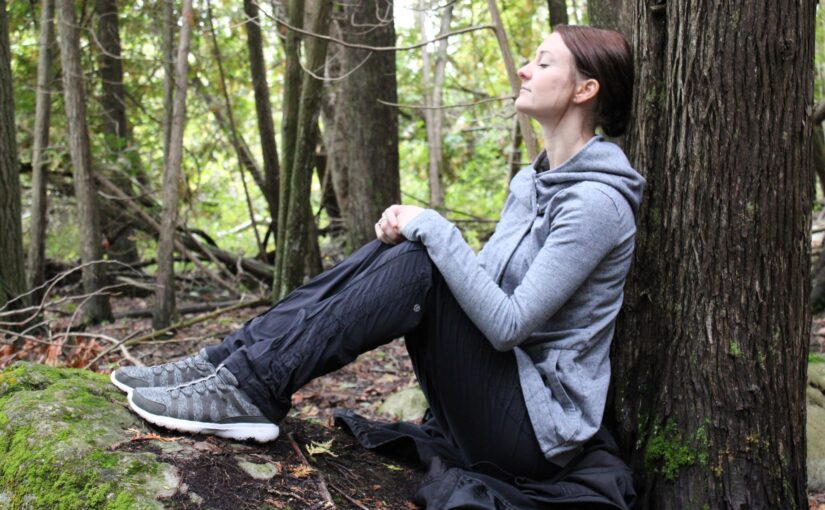Today’s blog comes from Dr. Romola Porchuk from the Global Institute of Forest Therapy and Nature Connection, and Cortney LeGros, the Healthy Parks Healthy People coordinator at Ontario Parks.
Forest therapy is much more than just a walk in the woods.
It’s all about the journey, not the destination, or the number of steps you track.
As you move your way through a forest therapy trail you might start with a deep breath, close your eyes for a moment, and allow your senses to guide you.
Forest therapy in Ontario Parks
Ontario Parks recognizes the profound health benefits of being outside in nature.
In fact, the cornerstone of our Healthy Parks Healthy People initiative is to share these benefits with all Ontarians.
One of the ways we encourage you to use parks for your restorative health is through the new self-guided forest therapy trail.
MacGregor Point Provincial Park is home to the first designated forest therapy trail in Ontario Parks.

Along the Tower Trail, you will soon find a series of mindfulness prompts inviting you to explore a deeper connection within nature and within yourself.
The forest therapy trail not only consists of a self-guided walk, but also includes a research survey to help us learn more about the benefits of forest therapy.
The project is a collaboration between Ontario Parks, the Global Institute of Forest Therapy and Nature Connection (GIFT), and donors whose generous donations made this project possible.
If you are interested in donating to projects like this now or in the future, please visit Ontario Parks’ donate page.
What is forest therapy?
We all know that going for a hike in the woods feels good.
Forest therapy is different than a hike in the woods.

In slowing down to awaken our senses, we bring our bodies into a deeper awareness of the forest — a place we evolved — and into our parasympathetic nervous system.
It is a gentle, physically undemanding practice that takes place in an area of a forest, or along a forest trail.
Forest therapy uses a series a specially designed invitations along a trail to help bring us into the present moment.
When we engage with the trail in a mindful way, these benefits have a deeper effect, and invite natural healing into the body and mind.
The science
The forest is filled with things that help our systems rest and repair. For example, bird song is a pleasurable sound and makes our systems feel safe.
The patterns in leaves and light calm our minds, helping us to focus and let go of anxious thoughts.

Phytoncides, the essential medicine of trees, help our bodies lower blood pressure, increase our immunity, and strengthen our hearts.
Research strongly supports that forest therapy walks can:
- Boost our immune system
- Lower blood pressure
- Improve heart rate variability
- Stabilize moods
- Reduce stress
- Improve sleep
Japan has led the way in understanding the wellness effects of forest therapy on dementia, ADHD, depression, anxiety, stress reduction, blood pressure benefits, and immunity.
The UK has conducted wellness research on forest therapy walks and has provided the foundation for wellness prescriptions covered by UK health care.
Ontario Parks has teamed up with GIFT to create the first ever forest therapy trail at MacGregor Point!
Along with establishing this trail, we are also conducting a research survey to help understand the health benefits of forest therapy.
Who is GIFT?
The Global Institute of Forest Therapy and Nature Connection (GIFT) has begun to collect and contribute to a body of data and research.
As well as training forest therapy guides, GIFT designs and designates forest therapy trails in parks and municipalities across Canada.
This collaboration with Ontario Parks includes both the installation of a forest therapy trail at McGregor Point, and a participant survey to assess the influence on our mental and emotional state of spending time in nature in this way.

That said, beyond the science, is the magic. The advantages of deep nature connection are often beyond the physical health benefits.
The connection nature offers often brings about surprising moments of a palpable balm that soothes the mind, the heart, and the fatigue of life.
There is something bigger that emerges, the felt sense of the present moment, embodied connection, and perhaps even a profound sense of support or insight that comes from slowing down in nature.
What often emerges is seeing nature and ourselves with new eyes and a felt sense of restoration.
Feel the benefits for yourself
Be sure to follow along for updates on the Forest Therapy Trail at MacGregor Point Provincial Park.
Ontario Parks thanks corporate partners  like GIFT for their support.
like GIFT for their support.
